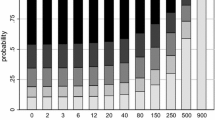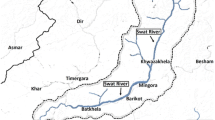Abstract
The European Water Framework Directive (WFD) includes an article on the mandatory provision for environmental and resource costs and benefits in pricing water services. Valuing water resources—e.g., regarding water quality, water availability, ecology, and biodiversity—is therefore an increasingly important topic for all water-related policies, such as the provision of drinking water, waste-water treatment, hydrological engineering, and ship transport. The current study provides empirical evidence on a specific river restoration project in the Danube National Park (Austria) combining improvements in water quality, the reduction of flood risks, and ecological benefits in terms of providing improved groundwater and flooding dynamics in the adjacent wetlands. Our study allows us to test whether willingness-to-pay (WTP) bids of respondents for such programs are different between two identical surveys employed in different years, and between two scenarios differing in scope. The results are encouraging regarding the (short-term) temporal stability of preferences for river restoration. Except for minor differences which are not statistically significant, we find empirical (econometric) indications that WTP bids were roughly in the same order of magnitude between the two surveys. The results of the paper suggest that from the viewpoint of temporal stability, WTP bids may be reasonably transferred over time.



Similar content being viewed by others
Notes
Bliem et al. (2012) present the results of a test on temporal stability of values for river restoration in a choice experiment setting.
The slight differences between the two surveys and the Austrian average might play some role in using WTP data for cost-benefit analysis. On the one hand, the results may indicate that benefits of river restoration may be unevenly distributed between different social groups. On the other hand, this also raises the question of the robustness of eliciting WTP values by means of surveys. For instance, one might wonder whether certain social groups have higher (dis-) incentives to engage in surveys (e.g., lower/higher opportunity costs). However, we think that the differences in the current survey are too small to argue for non-robust results since most surveys include some differences between sample and total population—differences, for which we try to control in our econometric estimations.
Details can be sent by authors on request.
As the sample was not stratified with respect to distance to the Danube River, this result has to be treated with caution.
References
Aschauer A, Zieritz I, Wimmer R, Deutsch K, Chovanec A (2006) WGEV Datenbank Fließgewässer, Berichtsteil Donau. Research Report of the Austrian Environmental Protection Agency (Umweltbundesamt, UBA), Vienna
Bliem M, Getzner M, Rodiga-Laßnig P (2012) Temporal stability of individual preferences for river restoration in Austria using a choice experiment. J Env Man (forthcoming)
Brouwer R (2006) Do stated preference methods stand the test of time? A test of the stability of contingent values and models for health risks when facing an extreme event. Ecol Econ 60:399–406
Brouwer R, Bateman I (2005) Temporal stability and transferability of models of willingness to pay for flood control and wetland conservation. Water Resour Res 41:W03017
Brouwer R, Bateman IJ, Barton D, Georgiou S, Martín-Ortega J, Pulido-Velazquez M, Schaafsma M (2009) Economic valuation of environmental and resource costs and benefits in the water framework directive: technical guidelines for practitioners. Institute for Environmental Studies, VU University, Amsterdam
Brouwer R, Bliem M, Flachner Z, Getzner M, Milton S, Palarie T, Szerényi Z, Vadineanu A, Wagtendonk A (2011) Valuation and transfer of ecological restoration benefits in the International Danube River Basin using choice experiments and GIS based value maps (paper currently under review)
Cameron J (1997) Applying socio-ecological economics: a case study of contingent valuation and integrated catchment management. Ecol Econ 23:155–165
Carson R, Hanemann W, Kopp R, Krosnick J, Mitchell R, Presser S, Ruud P, Smith V, Conaway M, Martin M (1997) Temporal reliability of estimates from contingent valuation. Land Econ 73:151–163
Danube National Park Administration (2007) Personal communication and information
Friedl B, Gebetsroither B, Getzner M (2009) WTP for species conservation pro-grams: implications for national park management. Eco.Mont J Prot Mount Areas Res 1:9–14
Hein T, Baranyi C, Reckendorfer W (2006) Bedeutung der hydrologischen Vernetzung für die hydrologische Situation der Augewässer im Bereich Orth an der Donau, vol. 10. Wissenschaftliche Reihe Nationalpark, Donau-Auen
Kealy M, Dovidio J, Rockel M (1988) Accuracy in valuation is a matter of degree. Land Econ 64:158–171
Kealy M, Montgomery M, Dovidio J (1990) Reliability and predictive validity of contingent values: does the nature of the good matter? J Env Econ Man 19:244–263
Kosz M (1996) Valuing riverside wetlands: the case of the Donau-Auen national park. Ecol Econ 16:109–127
Lindhjem H, Navrud S (2008) How reliable are meta-analyses for international benefit transfers? Ecol Econ 66:425–435
McConnell K, Strand E, Valdes S (1998) Testing temporal reliability and carry-over effect: the role of correlated responses in test-retest reliability studies. Env Res Econ 12:357–374
Richardson L, Loomis J (2009) The total economic value of threatened, endangered and rare species: an updated meta-analysis. Ecol Econ 68:1535–1548
Schabuss M, Schiemer F, Habersack H, Liedermann M (2006) A comprehensive concept for an eco-hydrological assessment of large scale restoration programs of floodplain rivers. Paper presented at the 36th International Conference of the International Association for Danube Research, “Interfacing the past and the future of ecology and water management in a large European river”, Vienna, Klosterneuburg, September 2006
WFD (2000) Directive 2000/60/EC of the European Parliament and of the Council of of 23 October 2000 establishing a framework for Community action in the field of water policy. Official Journal of the European Communities L 327/1 (22 December 2000)
Wilson MA, Hoehn JP (2006) Valuing environmental goods and services using benefit transfer: the state-of-the art and science. Ecol Econ 60:335–342
Acknowledgments
This study was carried out as part of the EU DG Research funded project AquaMoney (SSPI-022723) (http://www.aquamoney.org) and was also financially supported by the Research Council of Klagenfurt University. The authors are thankful for comments and suggestions to R. Brouwer, and to two anonymous reviewers for most helpful comments. All errors are, of course, the responsibility of the authors.
Author information
Authors and Affiliations
Corresponding author
About this article
Cite this article
Bliem, M., Getzner, M. Willingness-to-pay for river restoration: differences across time and scenarios. Environ Econ Policy Stud 14, 241–260 (2012). https://doi.org/10.1007/s10018-012-0029-3
Received:
Accepted:
Published:
Issue Date:
DOI: https://doi.org/10.1007/s10018-012-0029-3




